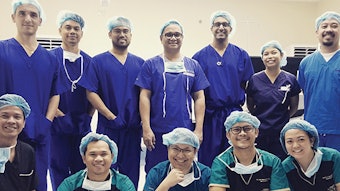We Must Do Better: Zeroing Out Preventable Errors
Since the release of the 1999 Institute of Medicine (IOM) report on medical errors, To Err Is Human: Building a Safer Health System, over 20 years ago, there have been considerable effort and resources applied attempting to identify preventable causes of these errors and limit their occurrence through system improvement and education.
 James C. Denneny III, MD AAO-HNS/F EVP/CEO
James C. Denneny III, MD AAO-HNS/F EVP/CEO
When To Err Is Human was released, it was estimated that 2-4 percent of deaths, or roughly 98,000 deaths per year, were related to medical errors. Most recent figures range from 250,000 deaths yearly up to 440,000 deaths yearly in the U.S. Using the lower figure, that is the equivalent of three jet airliners full of passengers crashing every day. This places medical errors as the third leading cause of death in America. Whether that indicates that our system is getting less safe or that we are better at identifying these causes is irrelevant. We must do better!
When this information first became available and early research suggested systemic improvements could offer protections against such events, particularly in the operating room, there was considerable resistance to initial suggestions and process alterations by those who denied the problem or thought it could never happen to them. Even when effective policies were put in place, many times they were not followed. While attending a recent Triological Society meeting, I had the great fortune to hear CAPT Ryan Carron (U.S. Navy) deliver an emotional and outstanding lecture titled, “Patient Safety: How to Avoid Medical Errors.” He is a career naval officer specializing in safety for a variety of naval operations as well as quality control and problem investigation. He related a personal event where both systemic and personal failure in a medical situation resulted in an unspeakable tragedy for him and his wife.
He subsequently reviewed the event through the eyes of a quality-control and safety expert in another field and identified areas for improvement in collaboration with the hospital system and has helped implement these locally.
Medical errors will typically fall within these general categories: adverse drug reactions, medication errors, laboratory errors, surgical errors, patient-controlled analgesia, falls, and healthcare-associated infections. In general, medication errors are the most commonly occurring medical error resulting in death. The Agency for Healthcare Research and Quality (AHRQ) attributes most medical errors to eight common root causes, including communication problems, inadequate information flow, human problems, patient-related issues, organizational transfer of knowledge, staffing patterns and workflow, technical failures, and inadequate policies. The agency considers communication problems by far the most important of the group. Review of both the general categories of medical errors and the root causes of errors within these categories would suggest significant potential for meaningful improvement in all these areas.
The AAO-HNS has had an active Patient Safety Quality Improvement (PSQI) Committee for many years. The committee has been instrumental in the creation of the Patient Safety Event Reporting Tool that allows members to report adverse events in otolaryngology. This database contains de-identified patient data for study in a secure environment. This web link follows AHRQ guidelines and helps identify areas of focus for future research. The committee also was instrumental in a comprehensive study of tracheotomies using a combination of national survey data and multi-institutional data to develop a series of manuscripts regarding the outcome for patients with tracheotomies, including actionable items with the potential to materially decrease adverse events and improve outcomes. It also recently completed a study on post-tonsillectomy admission practices, looking at the likelihood of accidental death and postoperative delayed bleeding complications to help physicians make rational decisions about postoperative admission practices that emphasize safety. This month’s Bulletin gives us a first look at their most recent project involving “Intraoperative Sentinel Events.”
Following the completion of his talk, CAPT Carron asked the audience a survey question that was thought-provoking. He asked the audience if they would rather have a grade “A” participant in a grade “B” system or a “B” participant in an “A” system. The audience was split almost evenly on their answers. CAPT Carron favored the grade “A” system. I feel to really move the needle in the right direction we shouldn’t settle for anything other than an “A” for both. Defining our goal and training participants to work in a culture that demands high quality and safety will be critical to addressing this unacceptable problem. The Academy will continue to identify and promote improvement activities that will move us toward the goal of no preventable errors.










